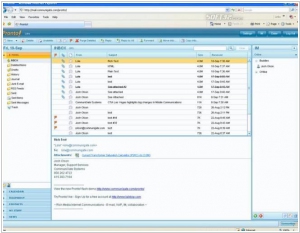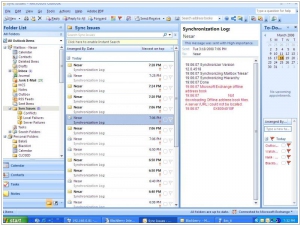Communigate Pro vs Microsoft Exchange
March 10, 2025 | Author: Adam Levine
1★
Russian client-server platform for unified communications. The CommuniGate Pro Server application processes requests sent over the network by a variety of clients - communication applications installed on desktops, laptops, mobile devices and other end-user systems. These client applications provide users with E-mail, groupware, IM/Presence, telephony, and other services by connecting to the CommuniGate Pro Server via its extensive set of supported standard protocols
20★
Microsoft Exchange Server is the server side of a client–server, collaborative application product developed by Microsoft. Exchange's major features consist of electronic mail, calendaring, contacts and tasks; support for mobile and web-based access to information; and support for data storage.
Both Communigate Pro and Microsoft Exchange are like two intergalactic supercomputers, each capable of managing the vast universe of email, calendars and contacts. They both allow users to navigate through this digital cosmos with webmail interfaces and communicate using the universally accepted protocols of IMAP, SMTP and POP3. The only thing that might separate them is whether you're trying to manage your emails on a starship or in an office full of very serious people—either way, they scale up just fine.
Now, if you're dealing with Communigate Pro, you're likely to be a nimble space captain, running a lean ship with small-to-medium sized operations. Born in 1991 from the minds of CommuniGate Systems in the United States, it’s the sort of system that works quietly in the background, performing everything from emails to VoIP, while hardly taking up any resources. It doesn't need to be the biggest ship in the fleet, but it can do just about anything if you’ve got the right configuration and a bit of imagination.
Then there's Microsoft Exchange, the heavy-duty, all-in-one star cruiser of the corporate world. Launched in 1996 by Microsoft (also from the United States), it thrives on the kind of massive, structured environments where a vast fleet of Outlook users is expected to sail in perfect formation. It's not just about sending emails—it's about compliance, data protection and integration with the entire Microsoft empire. It's more complicated, requires more resources, but offers an ecosystem that’s as finely tuned as a hyperdrive engine.
See also: Top 10 Unified Communications software
Now, if you're dealing with Communigate Pro, you're likely to be a nimble space captain, running a lean ship with small-to-medium sized operations. Born in 1991 from the minds of CommuniGate Systems in the United States, it’s the sort of system that works quietly in the background, performing everything from emails to VoIP, while hardly taking up any resources. It doesn't need to be the biggest ship in the fleet, but it can do just about anything if you’ve got the right configuration and a bit of imagination.
Then there's Microsoft Exchange, the heavy-duty, all-in-one star cruiser of the corporate world. Launched in 1996 by Microsoft (also from the United States), it thrives on the kind of massive, structured environments where a vast fleet of Outlook users is expected to sail in perfect formation. It's not just about sending emails—it's about compliance, data protection and integration with the entire Microsoft empire. It's more complicated, requires more resources, but offers an ecosystem that’s as finely tuned as a hyperdrive engine.
See also: Top 10 Unified Communications software





